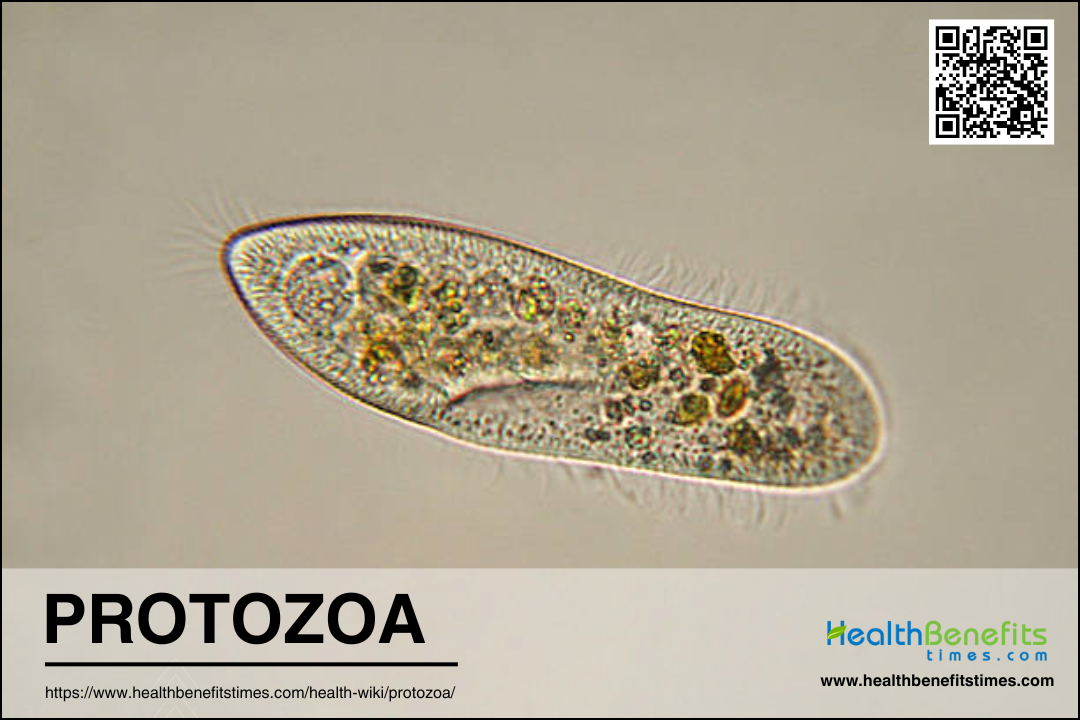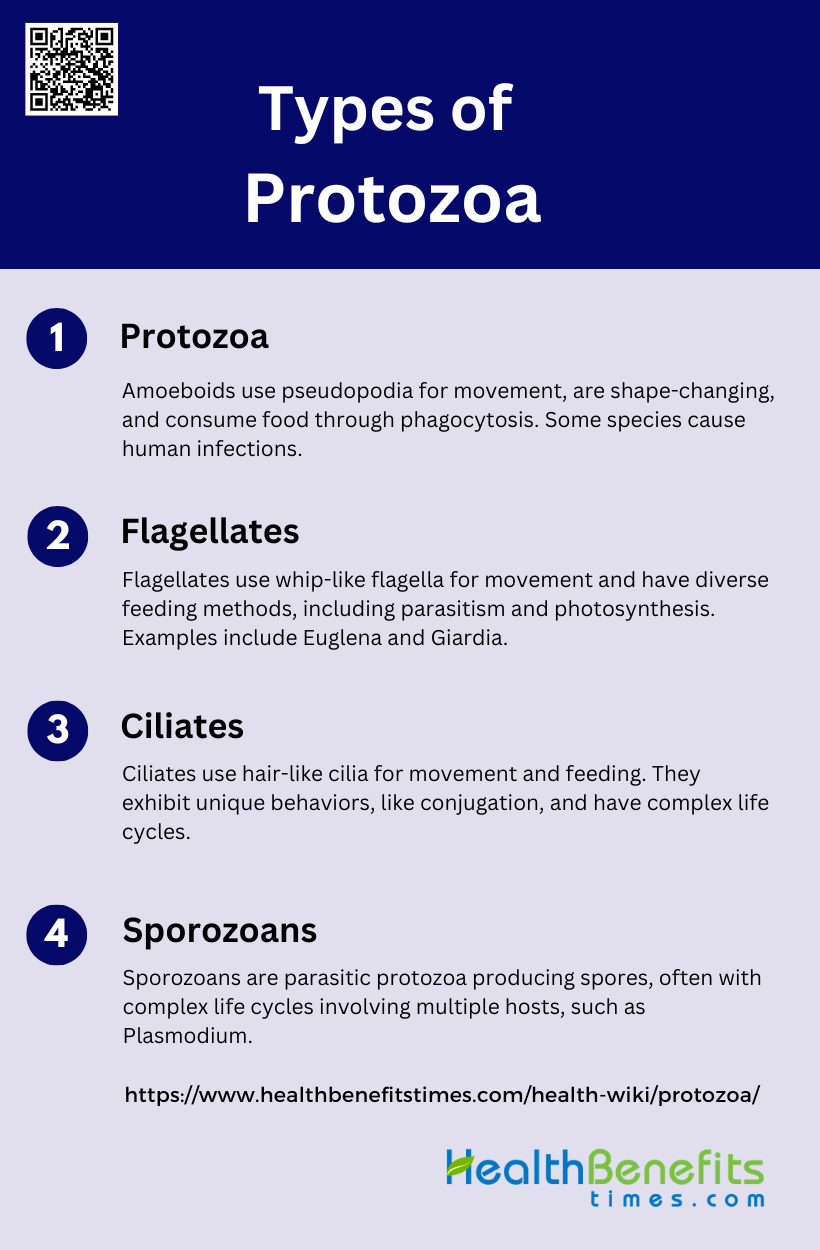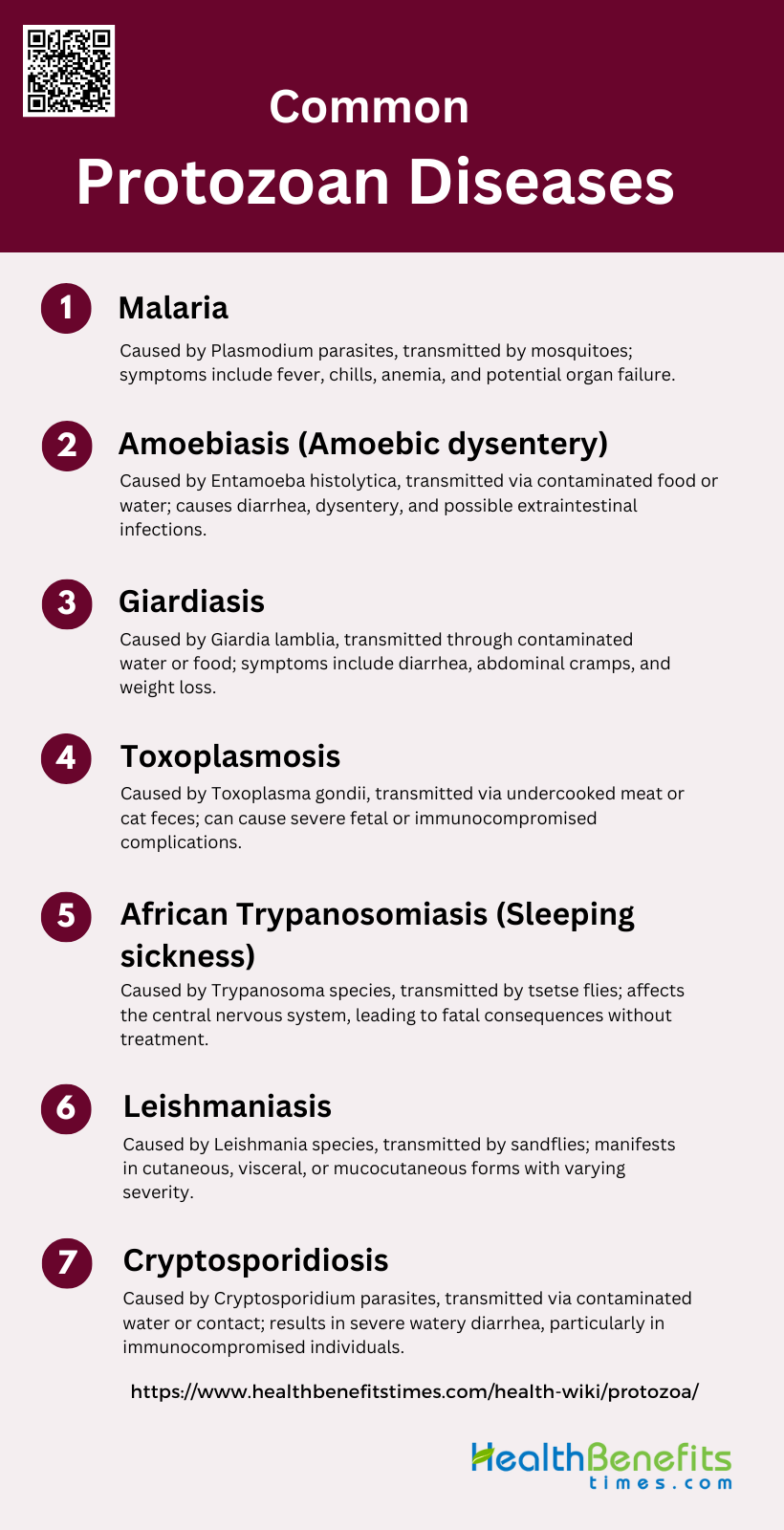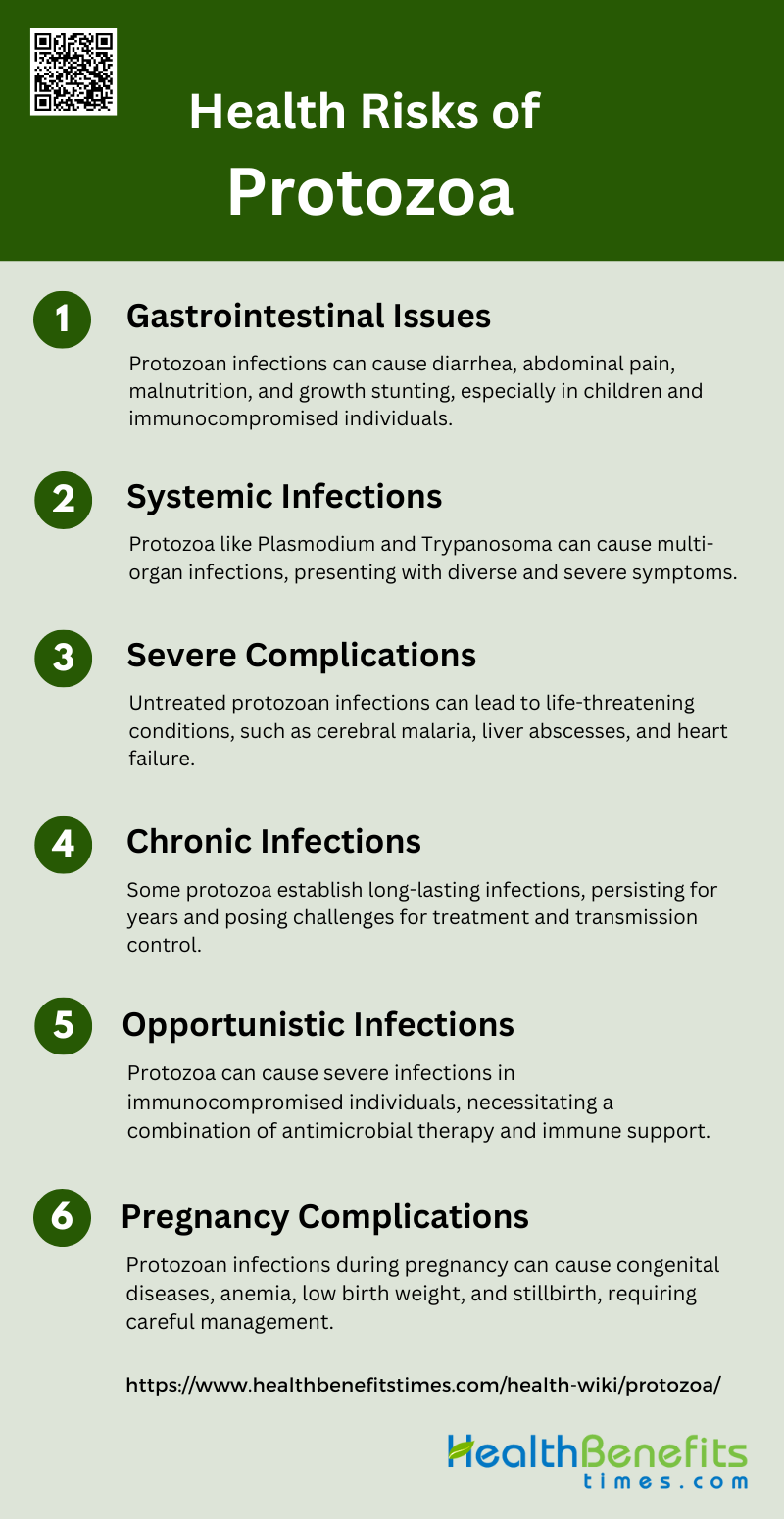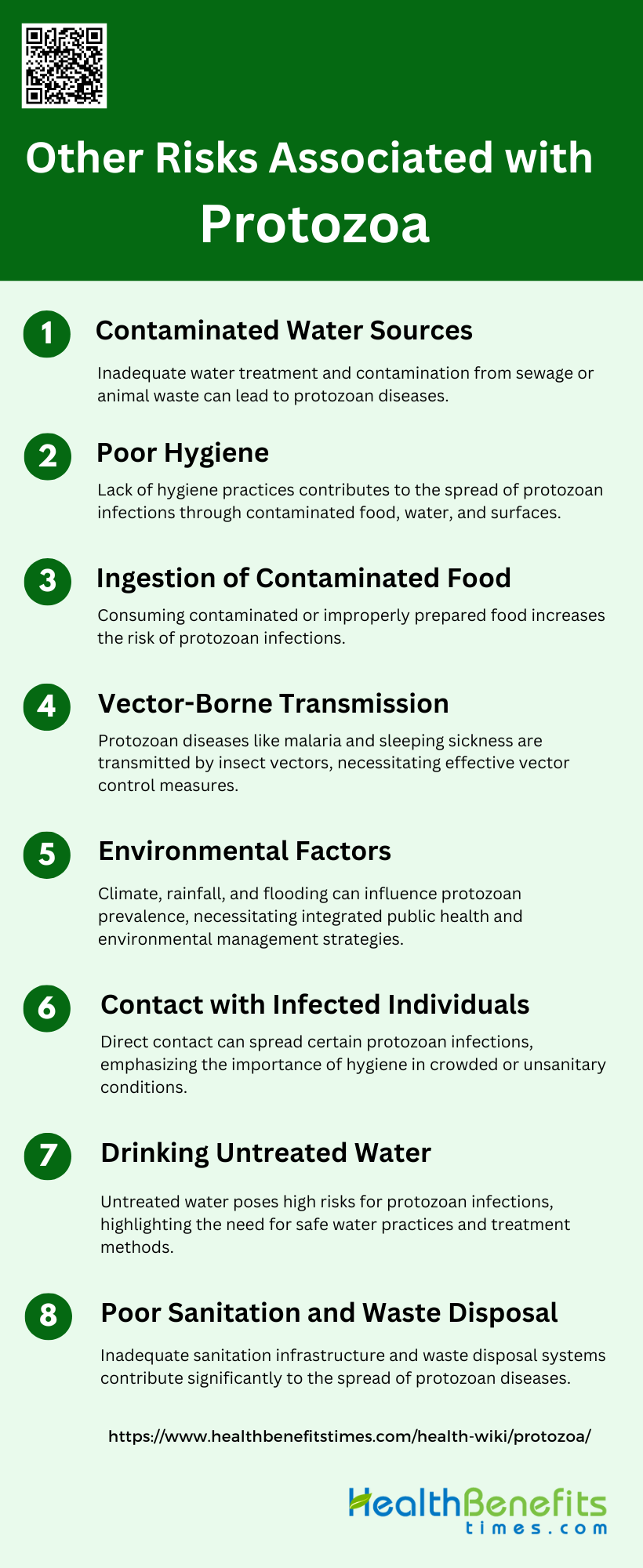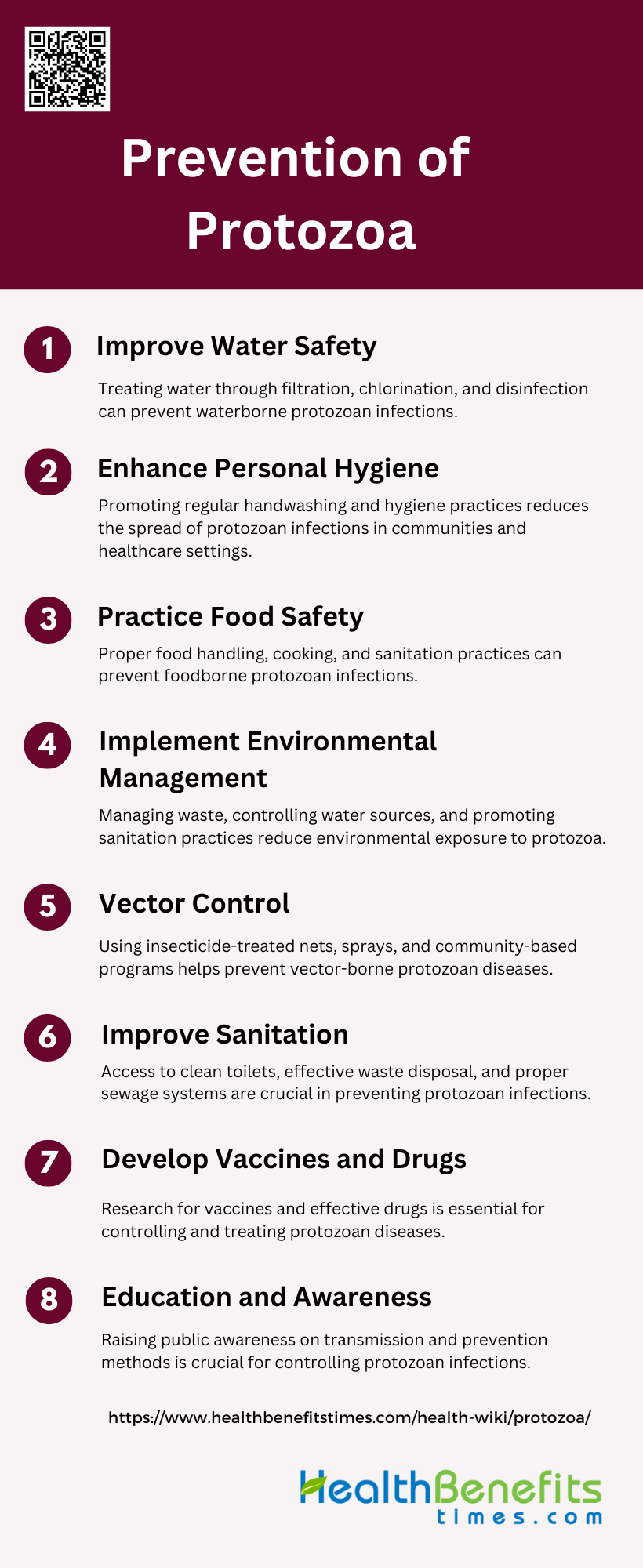Protozoa are single-celled eukaryotic microorganisms that belong to the kingdom Protista. These microscopic organisms are diverse in their structure, behavior, and habitat, ranging from free-living forms found in aquatic environments to parasitic species that can cause diseases in humans and animals. Protozoa are characterized by their ability to move independently, typically through structures like cilia, flagella, or pseudopodia, and they obtain nutrients by ingesting other organisms or organic matter. Some well-known examples of protozoa include Plasmodium (the causative agent of malaria), Paramecium, and Amoeba. Despite their simplicity, protozoa play crucial roles in various ecosystems and have significant impacts on human health, making them an important subject of study in fields such as microbiology, ecology, and medicine.
Types of Protozoa
Protozoa are a diverse group of single-celled eukaryotic organisms that can be found in various environments, from freshwater and marine habitats to soil and the intestines of animals. They are classified based on their movement mechanisms and other distinct features. Here, we explore four major types of protozoa:
1. Amoeboids
Amoeboids are characterized by their ability to change shape and move using pseudopodia, temporary extensions of their cell membrane. These single-celled organisms lack a fixed body shape and can engulf food particles through phagocytosis. Notable examples include Amoeba proteus, commonly found in freshwater environments, and Entamoeba histolytica, a parasitic species that can cause amoebic dysentery in humans. Amoeboids play crucial roles in aquatic ecosystems as predators of bacteria and other microorganisms. Some species, like Naegleria fowleri, are known for their potential to cause rare but severe infections in humans, such as primary amoebic meningoencephalitis.
2. Flagellates
Flagellates are protozoa that possess one or more flagella, whip-like structures used for locomotion. These organisms are found in diverse habitats, including freshwater, marine environments, and as parasites in animals. Key features of flagellates include their ability to move rapidly through liquid media and their varied nutritional strategies, ranging from photosynthesis to heterotrophy. Examples of flagellates include Euglena, a genus capable of both photosynthesis and heterotrophy, and Trypanosoma, a parasitic genus responsible for diseases like African sleeping sickness. Giardia lamblia, another notable flagellate, is a common intestinal parasite that can cause giardiasis in humans and animals.
3. Ciliates
Ciliates are characterized by the presence of numerous hair-like structures called cilia covering their cell surface. These cilia are used for locomotion and feeding, allowing ciliates to move efficiently through water and create currents to draw in food particles. Paramecium is a well-known example of a ciliate, often used in educational settings due to its large size and easily observable features. Ciliates exhibit unique behaviors such as conjugation, a form of sexual reproduction where two individuals exchange genetic material. Some ciliates, like Stentor, can reach sizes visible to the naked eye and display complex behaviors, including the ability to contract and extend their bodies.
4. Sporozoans
Sporozoans are a group of protozoa that typically produce spores as part of their life cycle. These organisms are exclusively parasitic and often have complex life cycles involving multiple hosts. The most well-known examples of sporozoans belong to the genus Plasmodium, which causes malaria in humans and other animals. Other notable sporozoans include Toxoplasma gondii, which can infect a wide range of warm-blooded animals, including humans. Sporozoans have a significant impact on human and animal health, causing diseases that affect millions of people worldwide. Their complex life cycles and ability to evade host immune responses make them challenging to control and treat.
Common Protozoan Diseases
Protozoan diseases are caused by single-celled organisms known as protozoa. These diseases can be transmitted through various means such as insect bites, contaminated food, and water. Below are some common protozoan diseases, their causes, modes of transmission, and symptoms:
1. Malaria
Malaria is caused by Plasmodium parasites transmitted through the bite of infected female Anopheles mosquitoes. The disease is prevalent in tropical and subtropical regions, particularly in Africa. Symptoms typically appear 10-15 days after the infective mosquito bite and include fever, chills, headache, muscle aches, and fatigue. In severe cases, malaria can lead to anemia, respiratory distress, and organ failure. The COVID-19 pandemic has disrupted malaria control efforts in some areas, highlighting the need for innovative approaches to information dissemination and vector control activities.
2. Amoebiasis (Amoebic dysentery)
Amoebiasis is caused by the protozoan parasite Entamoeba histolytica. Transmission occurs through ingestion of contaminated food or water containing cysts of the parasite. Symptoms range from mild diarrhea to severe dysentery with blood and mucus in stools. In some cases, the parasite can invade the intestinal wall, leading to extraintestinal infections. The disease is more common in areas with poor sanitation and hygiene. Children under 5 years of age are particularly susceptible, with the highest incidence rates observed in this age group.
3. Giardiasis
Giardiasis is caused by the flagellated protozoan Giardia lamblia. Transmission occurs through ingestion of cysts in contaminated water, food, or through direct fecal-oral contact. Symptoms include diarrhea, abdominal cramps, bloating, nausea, and weight loss. The disease is often asymptomatic in some individuals, who can still act as carriers. Giardiasis is a common cause of waterborne disease outbreaks and is particularly prevalent in areas with poor sanitation. Diagnosis is typically made through stool examination for ova and parasites.
4. Toxoplasmosis
Toxoplasmosis is caused by the protozoan parasite Toxoplasma gondii. Transmission occurs through ingestion of undercooked meat containing tissue cysts, contaminated water or food, or contact with cat feces. Most infections in healthy individuals are asymptomatic. However, in pregnant women, primary infection can lead to congenital toxoplasmosis, potentially causing severe complications in the fetus. Symptoms in immunocompromised individuals may include fever, headache, and lymphadenopathy. Ocular toxoplasmosis can cause chorioretinitis and vision problems.
5. African Trypanosomiasis (Sleeping sickness)
African Trypanosomiasis, also known as sleeping sickness, is caused by parasites of the genus Trypanosoma. It is transmitted to humans through the bite of infected tsetse flies. The disease occurs in two stages: the first stage involves fever, headaches, and joint pains, while the second stage affects the central nervous system, causing confusion, poor coordination, and disturbances in the sleep cycle. Without treatment, the disease is usually fatal. African Trypanosomiasis is endemic in parts of sub-Saharan Africa.
6. Leishmaniasis
Leishmaniasis is caused by parasites of the genus Leishmania and is transmitted through the bite of infected female phlebotomine sandflies. There are three main forms of the disease: cutaneous, visceral, and mucocutaneous. Cutaneous leishmaniasis causes skin lesions, while visceral leishmaniasis affects internal organs and can be fatal if left untreated. Mucocutaneous leishmaniasis leads to partial or total destruction of mucous membranes. Symptoms vary depending on the form of the disease but may include fever, weight loss, and enlargement of the spleen and liver.
7. Cryptosporidiosis
Cryptosporidiosis is caused by microscopic parasites of the genus Cryptosporidium. Transmission occurs through ingestion of contaminated water or food, or through contact with infected individuals or animals. The most common symptom is watery diarrhea, which can be accompanied by stomach cramps, dehydration, nausea, and vomiting. In immunocompromised individuals, the infection can be severe and potentially life-threatening. Outbreaks have been associated with contaminated drinking water sources, including well water. Prevention involves proper hygiene practices and water treatment.
Health risks of Protozoa
Protozoan infections pose significant health risks, affecting various systems in the body. These infections can lead to a range of health issues, from mild gastrointestinal disturbances to severe systemic complications. Below are some of the key health risks associated with protozoa:
1. Gastrointestinal issues
Protozoan infections commonly cause gastrointestinal problems, leading to significant morbidity worldwide. Parasites like Giardia lamblia, Entamoeba histolytica, and Cryptosporidium parvum can colonize the intestinal tract, causing symptoms such as diarrhea, abdominal pain, nausea, and vomiting. These infections can result in malabsorption of nutrients, dehydration, and weight loss. In severe cases, protozoan-induced diarrhea can be persistent and debilitating, particularly in immunocompromised individuals. The impact on children can be especially concerning, as prolonged diarrheal episodes can lead to growth stunting and developmental delays. Additionally, some protozoans like Entamoeba histolytica can cause more severe complications such as dysentery and liver abscesses.
2. Systemic infections
Some protozoan parasites can cause systemic infections that affect multiple organs and tissues beyond the gastrointestinal tract. Toxoplasma gondii, for example, can infect various cell types and organs, including the brain, eyes, and muscles. Malaria, caused by Plasmodium species, infects red blood cells and can lead to severe anemia, organ failure, and cerebral complications. Trypanosoma cruzi, the causative agent of Chagas disease, can affect the heart, digestive system, and nervous system over time. These systemic infections often present with a wide range of symptoms, including fever, fatigue, muscle aches, and organ-specific manifestations. The ability of these protozoans to disseminate throughout the body makes diagnosis and treatment challenging, often requiring specialized testing and prolonged therapeutic interventions.
3. Severe complications
Protozoan infections can lead to severe complications, especially if left untreated or in immunocompromised individuals. In the case of cerebral malaria, Plasmodium falciparum can cause life-threatening brain swelling, seizures, and coma. Amebic liver abscesses, a complication of Entamoeba histolytica infection, can result in severe pain, fever, and potential rupture if not properly managed. Toxoplasma gondii can cause ocular toxoplasmosis, leading to vision impairment or loss. In Chagas disease, chronic infection with Trypanosoma cruzi can result in cardiomyopathy, potentially leading to heart failure. Cryptosporidium and other opportunistic protozoans can cause severe, prolonged diarrhea in AIDS patients, contributing to wasting syndrome. These severe complications underscore the importance of early detection, proper treatment, and preventive measures against protozoan infections.
4. Chronic infections
Many protozoan parasites have the ability to establish chronic infections, persisting in the host for months or even years. Toxoplasma gondii can form dormant cysts in various tissues, remaining latent for extended periods and potentially reactivating when the immune system is compromised. Trypanosoma cruzi can cause a lifelong infection in Chagas disease, with symptoms manifesting decades after the initial infection. Chronic giardiasis can lead to long-term gastrointestinal issues and malabsorption. These persistent infections not only cause ongoing health problems but also serve as reservoirs for transmission to others. The chronic nature of these infections poses challenges for treatment and control, often requiring long-term management strategies and ongoing monitoring to prevent complications and reduce transmission risk.
5. Opportunistic infections
Protozoan parasites can cause opportunistic infections in individuals with weakened immune systems, such as those with HIV/AIDS, organ transplant recipients, or patients undergoing chemotherapy. Cryptosporidium, Microsporidium, and Toxoplasma gondii are common opportunistic pathogens that can cause severe and life-threatening infections in immunocompromised hosts. These infections often present with more severe symptoms and are more difficult to treat compared to infections in immunocompetent individuals. For example, cryptosporidiosis can cause prolonged, severe diarrhea in AIDS patients, leading to significant morbidity and mortality. Cerebral toxoplasmosis is a serious concern in HIV-positive individuals with low CD4 counts. The management of these opportunistic infections often requires a combination of antimicrobial therapy and immune system support.
6. Pregnancy complications
Protozoan infections during pregnancy can lead to serious complications for both the mother and the developing fetus. Toxoplasma gondii infection acquired during pregnancy can result in congenital toxoplasmosis, potentially causing severe neurological and ocular defects in the fetus. Malaria in pregnant women can lead to maternal anemia, low birth weight, preterm delivery, and increased risk of stillbirth. Trypanosoma cruzi can be transmitted congenitally, leading to congenital Chagas disease with potential long-term consequences for the child. These pregnancy-related complications highlight the importance of screening and preventive measures for pregnant women, especially in endemic areas. Proper management of protozoan infections during pregnancy often requires careful consideration of treatment options to balance maternal health with fetal safety.
Other Risks Associated with Protozoa
Protozoan infections are influenced by various environmental and behavioral factors. These risks can significantly increase the likelihood of contracting protozoan diseases. Below are some of the key risks associated with protozoa:
1. Contaminated Water Sources
Contaminated water sources pose a significant risk for protozoan infections. Protozoa can thrive in various water bodies, including recreational waters, where they occur naturally or due to contamination from sewage effluent, livestock, wildlife, and human activities. These microscopic organisms can cause a wide range of infectious diseases, including gastrointestinal illnesses, respiratory problems, and skin infections. The risk is particularly high in areas with inadequate water treatment facilities or where people rely on untreated water sources. For example, a study in Kampala, Uganda, identified the indiscriminate disposal of faecal waste into open stormwater drains as a major source of contamination, highlighting the need for improved sanitation infrastructure and waste management practices.
2. Poor Hygiene
Poor hygiene practices significantly contribute to the spread of protozoan infections. In food service establishments, inadequate hand hygiene among food handlers has been linked to the contamination of prepared foods and surfaces. A study found that 62.5% of food handlers’ hands were contaminated with various microorganisms, including potentially harmful bacteria. Poor personal hygiene, such as not washing hands with soap after defecation, has been associated with increased risk of infections like cholera. Improving hygiene awareness and practices in both public and private settings is crucial for reducing the transmission of protozoan parasites and other pathogens. Regular hand washing, proper food handling, and maintaining clean environments are essential preventive measures.
3. Ingestion of Contaminated Food
Ingestion of contaminated food is a common route for protozoan infections. Foodborne transmission can occur through various means, including the consumption of raw or undercooked foods, improperly washed fruits and vegetables, and food prepared in unsanitary conditions. A study in Dembi Dolo, Ethiopia, found that school children were particularly vulnerable to intestinal parasitic infections, including those caused by protozoa like Entamoeba histolytica and Giardia lamblia, due to the ingestion of contaminated food or water. Street food and uncooked produce were identified as dominant faecal exposure pathways in some urban areas. To mitigate this risk, proper food handling, thorough cooking, and washing of raw produce are essential practices.
4. Vector-Borne Transmission
While many protozoan infections are transmitted through contaminated water or food, some can also be spread through vectors. Although not explicitly mentioned in the search results, it’s important to note that certain protozoa, such as Plasmodium (which causes malaria) and Trypanosoma (which causes sleeping sickness), are transmitted by insect vectors. These vector-borne protozoan diseases pose significant health risks in many parts of the world, particularly in tropical and subtropical regions. Control measures for vector-borne transmission include the use of insecticide-treated bed nets, indoor residual spraying, and environmental management to reduce vector breeding sites. Public health efforts often focus on both vector control and treatment of infected individuals to break the transmission cycle.
5. Environmental Factors
Environmental factors play a crucial role in the prevalence and transmission of protozoan infections. Factors such as climate, rainfall patterns, and flooding can significantly impact the distribution and survival of protozoa in the environment. For instance, a study in Mandla District, India, found that a cholera outbreak began seven days after rainfall, suggesting a link between environmental conditions and disease transmission. Flooding and inadequate drainage infrastructure can lead to the presence of human excreta in the environment, increasing exposure risks. Climate change may exacerbate these environmental factors, potentially leading to changes in the geographic distribution and prevalence of protozoan infections. Addressing these environmental challenges requires integrated approaches that consider both public health and environmental management strategies.
6. Contact with Infected Individuals
Direct contact with infected individuals can contribute to the spread of certain protozoan infections, although this mode of transmission is less common than waterborne or foodborne routes for many protozoa. In crowded living conditions or areas with poor sanitation, person-to-person transmission can occur through contaminated hands or surfaces. This risk is particularly relevant in healthcare settings, where proper hygiene practices are crucial to prevent the spread of infections. While the search results don’t specifically address this mode of transmission for protozoa, it’s important to note that some protozoan parasites, such as those causing giardiasis, can be spread through close contact. Implementing proper hygiene practices, including hand washing and surface disinfection, is essential in preventing transmission through contact with infected individuals.
7. Drinking Untreated Water
Drinking untreated water poses a significant risk for protozoan infections. A study in a small island community in Malaysia found that 91.7% of water samples from untreated, gravity-fed drinking water sources were positive for E. coli, indicating fecal contamination. Despite this, many residents perceived the water as safe to drink without treatment, highlighting a disconnect between actual risk and risk perception. In areas where water treatment is inadequate or absent, protozoa like Cryptosporidium can persist and cause infections. The consumption of untreated water from wells, particularly those in paddy fields, has been associated with outbreaks of waterborne diseases. Promoting household water treatment methods and improving community water treatment systems are crucial steps in reducing the risk of protozoan infections from untreated water sources.
8. Poor Sanitation and Waste Disposal
Poor sanitation and inadequate waste disposal systems significantly contribute to the spread of protozoan infections. Open defecation, particularly around water sources or agricultural areas, can lead to widespread contamination. For example, a study in India observed open defecation in villages around paddy fields, which was linked to a cholera outbreak. Improper disposal of faecal waste, such as dumping into open stormwater drains, can contaminate water sources and increase exposure risks. Inadequate sanitation infrastructure in urban areas can lead to the presence of human excreta in the environment, creating multiple pathways for exposure to faecal contamination. Improving sanitation facilities, promoting the use of pit latrines, and implementing effective waste management systems are crucial for reducing the risk of protozoan infections and other waterborne diseases.
Prevention and Control Measures of Protozoa
Effective prevention and control measures are essential to reduce the incidence of protozoan infections. These strategies focus on improving water safety, personal hygiene, and environmental management. Below are some key measures to prevent and control protozoan infections:
1. Improve Water Safety
Ensuring safe water supply is crucial in preventing protozoan infections. This involves treating water sources through methods such as filtration, chlorination, and UV disinfection to eliminate parasites like Giardia and Cryptosporidium. In areas with limited access to clean water, simple interventions can be effective. For instance, exposing water to direct sunlight in UV-abundant environments can inactivate microorganisms like S. dysenteriae. Additionally, using iron pots for pasteurization and boiling water can significantly reduce the risk of waterborne protozoan diseases. Regular monitoring and maintenance of water treatment facilities are essential to maintain water quality and prevent outbreaks.
2. Enhance Personal Hygiene
Promoting good personal hygiene practices is fundamental in controlling protozoan infections. This includes regular handwashing with soap and clean water, especially before handling food, after using the toilet, and after contact with animals. In schools, providing adequate hand washing facilities and educating children about proper hygiene practices can significantly reduce the spread of intestinal parasites. For healthcare settings, strict adherence to hand hygiene protocols is crucial to prevent healthcare-associated infections. In water-scarce regions, innovative approaches like using alcohol-based hand sanitizers can be effective alternatives when soap and water are not readily available.
3. Practice Food Safety
Proper food handling and preparation practices are essential in preventing foodborne protozoan infections. This includes thoroughly washing fruits and vegetables, cooking food to safe temperatures, and avoiding cross-contamination between raw and cooked foods. In developing countries like Pakistan, addressing food safety issues is crucial in combating zoonotic diseases. Implementing food safety regulations, regular inspections of food establishments, and educating food handlers about hygiene practices can significantly reduce the risk of protozoan contamination. Additionally, promoting awareness about the risks associated with consuming raw or undercooked foods can help prevent infections like toxoplasmosis.
4. Implement Environmental Management
Environmental management plays a vital role in controlling protozoan infections by reducing exposure to contaminated soil and water. This includes proper waste management, improving drainage systems, and controlling stagnant water sources that can harbor parasites. In schools, maintaining clean classrooms, proper waste disposal, and ensuring a safe environment around the school premises are important measures. For communities in flood-prone areas, implementing flood control measures can help reduce the risk of waterborne protozoan outbreaks. Additionally, promoting proper sanitation practices and discouraging open defecation can significantly reduce environmental contamination with protozoan cysts and oocysts.
5. Vector Control
Many protozoan diseases, such as malaria and leishmaniasis, are transmitted by arthropod vectors. Effective vector control measures are crucial in preventing these infections. This includes using insecticide-treated bed nets, indoor residual spraying, and environmental management to reduce vector breeding sites. Recent advances in understanding vector-pathogen interactions have led to innovative control strategies, such as genetically modifying vectors to reduce their ability to transmit pathogens. Additionally, community-based vector control programs, involving education and active participation of local populations, can be highly effective in reducing disease transmission.
6. Improve Sanitation
Adequate sanitation facilities are crucial in preventing the spread of protozoan infections. This includes providing access to clean toilets, proper sewage systems, and effective waste management. In schools, ensuring the availability of hygienic toilet facilities and promoting their proper use can significantly reduce the prevalence of intestinal parasites among children. For communities lacking proper sanitation infrastructure, implementing low-cost solutions like composting toilets or community-led total sanitation programs can be effective. Improving sanitation not only prevents protozoan infections but also contributes to overall public health and dignity.
7. Develop Vaccines and Drugs
While prevention is key, developing effective vaccines and drugs is crucial for controlling protozoan infections. Research efforts are ongoing to develop vaccines against major protozoan diseases like malaria and leishmaniasis. For existing infections, ensuring access to effective antiparasitic drugs and promoting their proper use is essential. In areas with high disease burden, mass drug administration programs can be implemented to reduce overall parasite prevalence. Additionally, monitoring drug resistance and developing new treatment options are crucial for long-term disease control.
8. Education and Awareness
Raising public awareness about protozoan infections, their transmission routes, and prevention methods is crucial for effective disease control. This includes educating communities about the importance of hygiene, safe water practices, and proper sanitation. In schools, incorporating health education into the curriculum can instill good hygiene habits from an early age. For healthcare workers, continuous training on infection prevention and control measures is essential. Public health campaigns using various media channels can effectively disseminate information about protozoan diseases and their prevention to a wider audience.
FAQs
1. What are the differences between protozoan parasites and bacteria?
Protozoan parasites are single-celled eukaryotic organisms, which means they have a nucleus and other complex cellular structures. In contrast, bacteria are prokaryotic, lacking a defined nucleus. Additionally, protozoa often have more complex life cycles and can move using structures like cilia, flagella, or pseudopodia, whereas bacteria do not.
2. How can I protect myself from protozoan infections when traveling to endemic areas?
Travelers can protect themselves by drinking only bottled or boiled water, avoiding raw or undercooked foods, practicing good personal hygiene (like frequent handwashing), and using insect repellent or mosquito nets in areas where protozoan diseases like malaria are transmitted by vectors.
3. What is the role of protozoa in the environment?
Protozoa play a critical role in ecosystems by decomposing organic material, recycling nutrients, and controlling bacterial populations. They are also part of the food chain, serving as a food source for larger organisms.
4. Are there any beneficial protozoa for humans or the environment?
Yes, some protozoa are beneficial. For example, protozoa in the gut of termites help in digesting cellulose, while others play roles in nutrient recycling in the soil and water.
5. What are the signs that I might have a protozoan infection?
Symptoms of protozoan infections vary but can include diarrhea, abdominal pain, fever, chills, muscle aches, weight loss, fatigue, and more severe systemic symptoms depending on the specific infection.
6. How are protozoan infections diagnosed?
Diagnosis of protozoan infections typically involves laboratory tests, such as stool examinations for parasites, blood tests, biopsies, and molecular techniques like PCR to detect specific protozoan DNA.
7. Can protozoan infections be transmitted from person to person?
While most protozoan infections are transmitted through contaminated water or food, some can be spread directly from person to person, such as through close contact or fecal-oral routes.
8. Are there any vaccines available for protozoan infections?
Currently, there are no widely available vaccines for most protozoan infections, although research is ongoing for diseases like malaria. Preventive measures focus on vector control, sanitation, and safe food and water practices.
9. Can pets transmit protozoan infections to humans?
Yes, pets can be a source of certain protozoan infections, such as Toxoplasmosis from cats. It’s essential to practice good hygiene, like washing hands after handling pets, and cleaning litter boxes regularly.
10. What are the challenges in developing treatments for protozoan infections?
Challenges include the complex life cycles of protozoa, their ability to develop resistance to drugs, and the need for treatments that are safe for humans but effective against the parasites.


